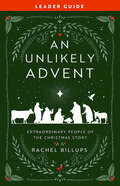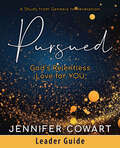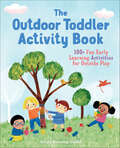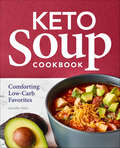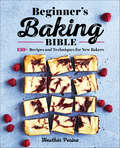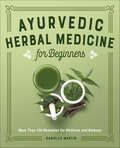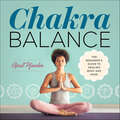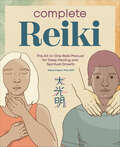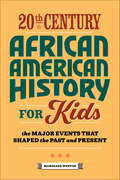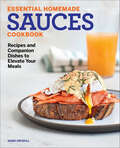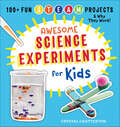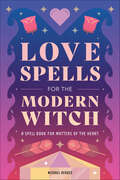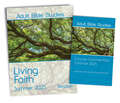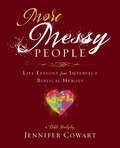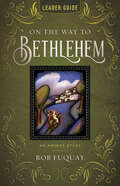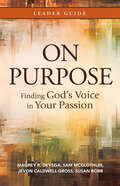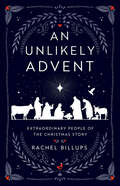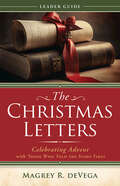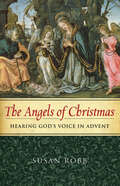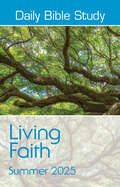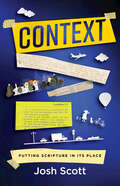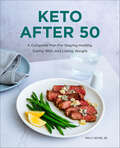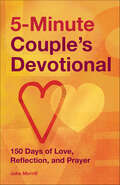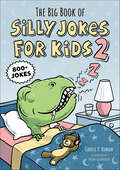- Table View
- List View
An Unlikely Advent Leader Guide: Extraordinary People of the Christmas Story
by Rachel BillupsExpect the unexpected this Christmas.This four-week Advent study focuses on the experiences of four sets of often overlooked characters in the Nativity story. During this Advent season, Rachel Billups guides readers through the themes of hope, love, joy, and peace by sharing the stories of Elizabeth and Zechariah, Herod, the Magi, and the shepherds. Each set of unexpected characters has something to teach about living faithfully on the journey to Christmas.The Leader Guide contains everything needed to guide a group through the four-week study, including session plans, activities, discussion questions, and multiple format options. Additional components for the four-week small group study include the book and DVD/Video Sessions featuring Rachel Billups.
Pursued - Women's Bible Study Leader Guide: Gods Relentless Love for YOU (Pursued)
by Jennifer CowartDiscover how God is pursuing you as you explore.We all want to be loved. We long to be desired, pursued—whether by a special someone, our friends, or others in our lives. This longing for love and acceptance is the underlying story of many of our lives, and it's the overarching story we see throughout the Scriptures. Although the Bible tells many stories, the main theme is God’s relentless love for us.In Pursued, a six-week Bible study by Jennifer Cowart, we will explore God’s great love for us from Genesis to Revelation. We will see that God passionately pursues people who do not deserve His love, and we are those people! Like Cain, Abraham, Sarah, Rebekah, David, the woman caught in adultery, Peter, and so many others, we are the ones who have broken relationship with God. But He runs after us anyway to bring us home. In this study, we will explore God’s love as evidenced in the stories of creation, the patriarchs, the judges and prophets, Jesus, and the early church. Together we will dive into a great love story and discover that it is our story!Through this study women will:- See the big picture of God’s love for them throughout the Scriptures- Discover that God wants a personal relationship with them- Experience God’s relentless love for them individually- Realize that God never stops pursuing themComponents for this six-week Bible study, each available separately, include a Participant Workbook, a Leader Guide, and video sessions with six 25-minute segments (with closed captioning).
The Outdoor Toddler Activity Book: 100+ Fun Early Learning Activities for Outside Play (Toddler Activity Books)
by Krissy Bonning-GouldEncourage learning through play with these fun outdoor activities for toddlers aged 1-3.Outdoor play promotes creativity, strengthens muscles, enhances social and emotional development, and makes learning fun. This book is packed with dozens of engaging and educational toddler activities that emphasize early learning and get kids excited about being outside.Each chapter is devoted to a specific type of toddler-friendly play: messy play, active games, nature-based activities, water activities, and outdoor arts and crafts. Bold icons show what each activity teaches your child, allowing you to choose activities appropriate for their developmental stage to help guide their growth.This colorful book of outdoor toddler activities includes:SKILL-BUILDING EXERCISES: Help your little one build up important skills like problem-solving, mindfulness, shapes and letters, sorting, patterns, and many more.ACTIVITY TIPS & TRICKS: Find suggestions for making the most out of each activity and "Caution!" labels for exercises that require increased supervision.DEVELOPMENTAL MILESTONES: Learn more about your child's motor, language, and social-emotional skills at each stage of development.Add more intentional play, meaningful connection, learning opportunities, and plain old fun to your toddler's days with help from The Outdoor Toddler Activity Book.
Keto Soup Cookbook: Comforting Low-Carb Favorites
by Jennifer AllenCreate keto soups that minimize carbs and maximize flavor There's nothing more comforting than a good bowl of soup. Finding keto versions of your favorites can be challenging, but you can now put soups back on the menu with the best soup cookbook for keto. Discover delicious recipes with simple, ketogenic-friendly ingredients and easy instructions that range from homestyle classics to creative new flavor combos.What sets this book apart from other soup cookbooks:60 different soups—From creamy vegetable soups to hearty meat and noodle stews, this book has traditional recipes with a keto twist, and new favorites like Salmon and Zucchini Chowder and Butternut Squash Soup with Turmeric and Ginger.A keto cooking guide—Learn the techniques for making any soup keto, and get the know-how you need to make the perfect bowl every time.Souped-up sides—Complement your favorite recipes with delectable keto crackers and breads, including olive focaccia and jalapeno cheese bread.Turn classic stews, chowders, and more into scrumptious, carb-reduced creations with the Keto Soup Cookbook.
Beginner's Baking Bible: 130+ Recipes and Techniques for New Bakers
by Heather PerineBaking is a piece of cake with this fundamental beginner's cookbook.Here's a little culinary secret. You can become a fantastic baker even if your cooking experience is limited to cracking a few eggs. All you need is The Beginner's Baking Bible.Baking becomes truly accessible thanks to this cookbook, which features:Breakdowns of baking basics—Learn how to utilize critical baking techniques such as mixing, folding, creaming, and kneading. Discover steps that will help you perfect your process.Tons of insider tricks—From ingredient substitutions to marshaling batter run amok, most recipes are paired with important tips designed to simplify and troubleshoot life in the kitchen.130+ scrumptious recipes—Enjoy making a wide variety of sweet and savory goodies including decadent spiced hot chocolate cookies, zesty lemon bars, or fresh and flaky summer vegetable tarts. No matter what you bake, these recipes will have family and friends reaching for seconds.Blossom into a confident baker with The Beginner's Baking Bible.
Ayurvedic Herbal Medicine for Beginners: More Than 100 Remedies for Wellness and Balance
by Danielle MartinLive better through the power of Ayurvedic herbal medicine For thousands of years, Ayurvedic herbal medicine has been used to help treat everything from anxiety to the common cold—and now you can learn how to make these traditional natural remedies at home. This guide is the perfect choice for anyone interested in exploring alternative medicine, introducing fundamental concepts in a way that's easy to understand.What sets this herbal medicine book apart:Ayurvedic herbology explained—Get started with an overview of what Ayurveda is and how it can benefit you, as well as the art of crafting herbal medicine.Herb profiles—From Ajwain (carom seed) to Yashtimadhu (licorice), discover 35 must-know Ayurvedic herbs, their various uses, and any precautions you should take when working with them.More than 100 healing remedies—Care for yourself and others by learning to make Allergy-Relief Honey, a Soothing Sore Throat Gargle, a Clarifying Hair Rinse, and more.Embrace the healing power of Ayurvedic herbalism with this beginner-friendly guide.
Chakra Balance: The Beginner's Guide to Healing Body and Mind
by April PfenderHelp heal your body and soul—the essential beginner's guide to balancing chakras.Chakra imbalances can manifest in a number of physical and emotional ailments. Chakra Balance is a practical beginner's guide to identifying energy imbalances, and restoring harmony with powerful, energy healing practices.Chakra Balance offers illustrated, easy-to-follow guidance for using yoga poses, crystals, and essential oils to harness your energy and heal. With in-depth profiles of each of the seven chakras, you'll gain a fundamental understanding of the physical, emotional, and spiritual elements of every chakra.Push past blockages and keep your chakras clear and open with:A symptom reference chart that allows you to diagnose which chakra is blocked based on the emotional or physical symptoms you experienceEffective, energy exercises that don't require previous experience and specifically target the chakra in distress through yoga, crystals, essential oils, and other healing practicesStraightforward chakra profiles that explain the characteristics and causes of imbalance for each chakraVisual guidance with photos, illustrations, and charts for easy referenceTake a deep breath. Tune into the energy running through you, and feel the connection between your mind and body with this practice-based guide for chakra healing.
Complete Reiki: The All-in-One Reiki Manual for Deep Healing and Spiritual Growth
by Karen FrazierThe complete Reiki reference for a new generation of healersReiki exists in abundance all around us, and everyone can benefit from its warm, loving energy for balance and healing. Learn how to harness this spiritual power with Complete Reiki, the all-in-one Reiki resource for deep healing and spiritual growth.Think of this book as your wise Reiki teacher, guiding you through your Reiki journey to spread healing to others. This comprehensive guide features straightforward and inclusive training that's accessible and approachable by all, with informative illustrations and instruction that make this book perfect for Reiki students of any age or background.With Complete Reiki, you can:Learn the history—Modern Reiki is a mix of Japanese, Western, and nontraditional Reiki; this book will walk you through the history of the practice and its influential figures.Master all levels—Study the three levels of Reiki—First Degree, Second Degree, and Master-Teacher Reiki— and train from novice to adept.Explore illustrated guides—Find visual references for Reiki symbols, hand positions, and physical healing sequences to perform energy healing on yourself and others.The guidance you need is now all in one place, with a Reiki book that covers what any practitioner needs to know.
20th Century African American History for Kids: The Major Events That Shaped the Past and Present (History by Century)
by Margeaux WestonShow kids ages 8 to 12 how Black Americans shaped US history in the 20th centuryFrom fighting against discrimination to changing the landscape of art and music, discover the incredible ways that Black Americans influenced the world we live in today. Spanning the 1900s through the 2000s, this journey through history introduces kids to the struggles and triumphs of Black people in the United States through 30 defining moments of the 20th century.Over the course of five easily digestible "eras," kids will learn about the founding of the NAACP, the Harlem Renaissance, the Tulsa Race Massacre, the March on Washington, the rise of the Black Power Movement, Jesse Jackson's voter registration drive, and more.Go beyond other American history books for kids with:An event-driven approach—A focus on putting things into context, not just memorizing names and numbers, allows kids to engage with history.Key callouts—Handy sidebars call special attention to important information and inspiring, influential Black history makers.Clear explanations—Each event is explored in a straightforward manner that makes it easy for kids to understand what occurred and why.Help kids discover the many ways that Black Americans have shaped the world they live in today.
Essential Homemade Sauces Cookbook: Recipes and Companion Dishes to Elevate Your Meals
by Mark DriskillAdd flair and elevate your culinary creations with sensational saucesSauces are fun ways to finish dishes with originality and exciting cultural variations. From vinaigrettes to barbeque to curries and even dessert finishings, The Essential Homemade Sauces Cookbook is filled with blends based on cream, eggs, herbs, tomatoes, and much more. Learn how each base ingredient works to create sauces with equally delicious and specific purposes.From Classic Marinara to Chile-Rubbed Hanger Steak with Classic Chimichurri, each sauce family begins with a basic version before branching out into more unique and interestingly delectable derivatives. Use the pairing charts to learn ideal matches with beef, chicken, lamb—even tofu! As you try each homemade sauce, your familiarity and confidence for sauce making will increase as well. It's time to get saucy!Inside you'll find:Sauce galore—Discover 15 sauce types with 3 recipes for each to appeal to a wide array of tastes, plus 2 companion dishes for each sauce family.Organized by family—In every chapter, each sauce is divided into clear and distinguishable families, an ode to the French mother sauces.Make it your own—Don't just follow these recipes—experiment with sauces and combinations to build something that's truly yours.Learn how accenting flavors elevates meals and expands your options!
Awesome Science Experiments for Kids: 100+ Fun STEAM Projects & Why They Work! (Awesome STEAM Activities for Kids)
by Crystal ChattertonThe ultimate science experiment book for kids! 100+ hands-on projects to get kids ages 5 to 10 excited about science.As kids grow older, they become more curious about the world around them, often asking, "How does this work?" Awesome Science Experiments for Kids teaches young brains the nuts and bolts of the scientific method using fun, hands-on experiments designed to show kids how to hypothesize, experiment, and then record their findings.It's great for fun anytime, but especially for turning your child's summer break into a period of fun-filled summer learning! With awesome projects like a Fizzy Rocket, Magnet-Powered Car, and Pencil Sundial, kids will have a blast learning to build, design, and think critically—while getting inspired to interact with the world around them and make their own discoveries. An amazing summer learning workbook, it guides young readers through numerous exciting projects that demonstrate the elegance and wonder of science in the most enjoyable way possible.Awesome Science Experiments for Kids includes:100+ STEAM experiments—Each activity includes an explanation of the processes in play, so kids can understand how and why each project works.Easy instructions—These step-by-step science experiments for kids simplify each process to make the projects fun and simple to understand—and they only require basic household materials.Colorful photos—Refer to real-life photos that show you how to bring these experiments to life.From learning how quicksand works to turning a lemon into a battery, these experiments teach budding STEAM kids how cool it is to be curious.
Love Spells for the Modern Witch: A Spell Book for Matters of the Heart
by Michael HerkesInvite and embrace the magic of love with this enchanting spell book We all have magic inside our hearts that can connect us with others and welcome new love into our lives. Manifest the magic of love with Love Spells for the Modern Witch. This spell book taps into the heart's power with a variety of spells, potions, and rituals for every kind of love.Go beyond other witchcraft spell books with:Modern love witchery—Understand the principal components of love and witchcraft, and find out how to ethically merge the two.Everyday practices—Learn how to use tools, carry out a ritual, and other methods and practices essential to witchcraft books.All kinds of love—Cast spells for modern life and love, from healing after heartbreak and building new relationships to growing in self-love.Craft a love story with a little bit of magic thanks to this powerful spell book.
Parables Leader Guide: Putting Jesus's Stories in Their Place
by Josh ScottRead the stories of Jesus in a new light.The Leader Guide contains discussion questions and session plans for a six-week study of Parables: Putting Jesus’s Stories in Their Place, by Josh Scott. It includes opening and closing prayers, optional activities, and session goals for each week and is designed to be used with the book and DVD.When Jesus taught in parables, he was doing more than telling simple morality tales. His stories were grounded in the world in which he lived and his vision of the Kingdom of God. This study explores six parables that give us a window into Jesus’s message and movement, and, once they are heard in their own context, ask what they might mean for us today. Parables include: the New Wine and Wineskins, the Mustard Seed, the Leaven, the Wedding Party, the Workers in the Vineyard, and the Wicked Tenants.
Adult Bible Studies Summer 2025 Teacher/Commentary Kit
by Clara K. WelchGrow your faith. Transform your life.The Kit includes a teacher’s book and a commentary that supplement and complement the Adult Bible Studies student book.The teacher’s book provides biblical background, exposition, and suggestions for leading weekly group discussions and nurturing spiritual practices among class members. Small group leaders, teachers, and facilitators—both seasoned and just starting out—love the easy-to-use format and the wealth of information provided to prepare for each week’s discussion.Based on the trusted Abingdon Basic Bible Commentary, the Concise Commentary provides expert biblical commentary for the focal Bible passages used in Adult Bible Studies. The commentary includes each Sunday’s focal Bible passages, unit introductions, and expert commentary on each passage. Plus, you can pronounce everything correctly with the included pronunciation guide for Bible names and places.Don’t miss out on the opportunity to enhance your preparation and teaching with the help of the Adult Bible Studies Teacher Book and Concise Commentary!Cultivate a deeper relationship with God through Adult Bible Studies. Each weekly lesson offers background and focal Scriptures, key verses, and doctrinally sound and relevant biblical interpretation and application in a readable font size. Annual plans provide comprehensive coverage of the Bible, special lessons during the church seasons of Advent/Christmas and Lent/Easter, and suggestions for developing spiritual practices such as prayer, worship, community, and service, among many others. Adult Bible Studies is a reliable companion and guide for learning and growing in the Christian faith.Spring 2025 Theme: Living FaithThis spring, our Bible lessons follow the theme “Living Faith.” They offer a series of lessons in two units during Lent and the weeks following that encourage us to consider what we need to let go of and what we need to take on as followers of Jesus.With the help of the Adult Bibles Studies Teacher/Commentary Kit, and DVD, your group will embrace the fact that it’s not just about learning - it’s about living out biblical teachings.Visit AdultBibleStudies.com and sign up for the weekly newsletter to automatically receive the FREE Current Events Supplement and other information about these resources and more!This resource, endorsed by the Curriculum Resources Committee of The United Methodist Church, offers a year-round, weekly Bible study plan for Sunday school classes and other small groups.
More Messy People Women's Bible Study Participant Workbook: Life Lessons from Imperfect Biblical Heroes
by Jennifer CowartGod can use imperfect people to do incredible things.Jen Cowart continues her study of the very messy lives of biblical heroes—people who, like us, made mistakes but found God was able to use them in powerful ways. They all play a significant role in the biblical narrative, but their stories are far from perfect.Through the lives of rival sisters like Leah and Rachel, or sisters with very different personalities like Martha and Mary, we see God chooses to use people who don’t have it all together. Through the lives of great, but imperfect, biblical heroes like Moses, Elijah, Peter, and Paul, we see God meets us in our troubles and chooses us even if we seem unqualified.The Participant Workbook includes five daily readings for each week, combining study of Scripture with personal reflection, application, and prayer and is designed to use with the Leader Guide and DVD.
On the Way to Bethlehem Leader Guide: An Advent Study
by Rob FuquayThe journey to Christmas begins in Rome.The leader guide includes four small group sessions complete with prayers, summaries, and discussion questions to inspire active group engagement. It will support group leaders of all experience levels in creating strong learning communities.On the Way to Bethlehem follows the long journey to Christmas. The story begins in Rome with a decree issued from the seat of worldly power for a census, setting into motion events leading to the birth of the Savior of the world in a town that represents the very opposite of worldly power, Bethlehem.Author Rob Fuquay provides insight into the geographical and historical significance of Rome, Jerusalem, Nazareth, and Bethlehem, along with the important characters through whom the Christmas drama unfolds. You will be drawn into those places in a way that helps you experience the spiritual truths each location holds. The reflection we give in these places prepares the heart and soul to experience wonder, awe, mystery, and joy.Chapters include:Rome – A Place of LongingJerusalem – A Place of WaitingNazareth – A Place of SimplicityBethlehem – A Place of HumilityComponents available to use this book in a small group study include the book and video available on DVD.
On Purpose Leader Guide: Finding God's Voice in Your Passion
by Susan Robb Sam McGlothlin Jevon Caldwell-Gross Magrey deVegaBe part of something more.We are hungry for a sense of purpose, direction, and calling in our lives. That’s as basic an ingredient to the human experience as they come. We want to be part of something bigger than ourselves. We want to participate in something that has eternal merit and lasting impact. We do not want to live a shallow, hollow existence. We yearn for deeper meaning, for deeper purpose within our lives. We want to be more than we are.In On Purpose: Finding God’s Voice in Your Passion, authors Magrey deVega, Sam McGlothlin, Jevon Caldwell-Gross, and Susan Robb help us see God's purpose for our lives, how to open ourselves to God's voice, and how to take the first or next step to follow God's call. As you read this book and explore your life alongside others, you’ll learn how to channel your passions, hear God’s voice, and live the life you were meant to live.The Leader Guide contains everything needed to guide a group through the four-week study, including session plans, activities, discussion questions, and multiple format options.Additional components for the four-week small group study include the book and DVD/Video Sessions featuring the authors.
An Unlikely Advent: Extraordinary People of the Christmas Story
by Rachel BillupsExpect the unexpected this Christmas.This four-week Advent study focuses on the experiences of four sets of often overlooked characters in the Nativity story. During this Advent season, Rachel Billups guides readers through the themes of hope, love, joy, and peace by sharing the stories of Elizabeth and Zechariah, Herod, the Magi, and the shepherds. Each set of unexpected characters has something to teach about living faithfully on the journey to Christmas.Additional components to use the book as a four-week small group study include a leader guide and DVD/Video Sessions featuring Rachel Billups.
The Christmas Letters Leader Guide: Celebrating Advent with Those Who Told the Story First
by Magrey deVegaHear from “those who told the story first.” The Leader Guide contains discussion questions and session plans for a four-week Advent study. It includes opening and closing prayers, optional activities, and session goals for each week, and is designed to be used with the book and DVD.You may or may not know the story of your birth. If you do, there is something special about hearing your origin story again and remembering how it all began for you. That’s why we observe Advent: to celebrate how it all began for us. In The Christmas Letters, Magrey deVega invites you to hear about the miracle of Christ’s birth from those who first told the story. The letters in the New Testament, known as the Epistles, contain the first attempts by the church to understand and celebrate the mystery of the Incarnation. They point us to the origins of what we believe about Jesus, fully human and fully divine. By spending time with these holy, ancient words this Advent, you’ll come to know the meaning of Christ’s coming like never before. Read the New Testament letters, Romans, 1 John, Philippians, and Colossians as your first Christmas letters of the season and find within them an invitation from God to deepen your understanding of the Incarnation and embrace a fuller commitment to Jesus Christ.
The Angels of Christmas: Hearing God's Voice in Advent
by Susan RobbExplore the four angelic visits surrounding the birth of Jesus with Susan Robb in The Angels of Christmas, a four-week Advent study. The Angels of Christmas: Hearing God’s Voice in Advent, a four-week Advent study by Susan Robb, explores the four angelic visits surrounding the birth of Jesus with Zechariah, Mary, Joseph, and the shepherds. In this study, the reader will explore the visits and dive deep into the history of the angel Gabriel–and other angels–in the Old Testament. The Angels of Christmas uses these four angelic appearances to discuss God’s presence in history and our lives today. The messages of the angels hold meaning for listeners both then and now.
Daily Bible Study Summer 2025
by Timothy Merrill Betsy Haas Rhoda E. PrestonGrow your faith daily. Transform your life.Experience God in deeper ways by spending time in God’s Word. Daily Bible Study is the perfect resource for individuals who want to grow in their relationship with God and enhance their engagement with lessons in Adult Bible Studies. Designed to meet the needs of busy people, each daily reading includes a Scripture reference, a personal faith-related question, an explanation and application of the biblical text, and a prayer, all on one page. Available in print and eBook and as an app.Summer 2025 Theme: Living FaithThis summer, Daily Bible Study presents a series of readings supporting the theme “Living Faith.” These readings, divided into three units, lead us to consider the church, the issues within it, the wisdom God provides in dealing with these issues, and the spiritual resources God provides for us to live into the church’s mission. These daily readings come from the Old and New Testament texts and prepare us for the lessons in Adult Bible Studies.This resource, endorsed by the Curriculum Resources Committee of The United Methodist Church, offers a year-round, daily Bible study plan.
Context: Putting Scripture in Its Place
by Josh ScottExploring the Chapter Behind the Verse. Context looks at verses we know by heart but may not know the people, places, and times that give them meaning. Josh Scott delves into these well-known Scripture verses, exploring their true meanings by examining them in their original biblical context. Through this process, he unveils fresh and enlightening interpretations that are often missed when these Scriptures are taken out of context. The book can be read alone or used by small groups anytime throughout the year. Components include video teaching sessions featuring Josh Scott and a comprehensive Leader Guide, making this perfect as a six-week group study.
Keto After 50: A Complete Plan For Staying Healthy, Eating Well, and Losing Weight
by Molly DevineA comprehensive guide to going keto for anyone 50 and overDiscover how keto can work for you! No matter your reasons for changing what you're eating, Keto After 50 gives you a detailed overview of what keto is, how it can help you lose weight, and the other unique benefits it offers. Set yourself up for success with a satisfying meal plan, helpful shopping lists, and more.Keto After 50 features:Keto explained—Learn all about ketosis and necessary macronutrients specifically for people over 50, as well as how the ketogenic diet can help with everything from cardiac health to neurological function and arthritis.A 28-day plan—Keto After 50 helps keep your new diet manageable with four weeks of pre-planned meals that ease you into the ketogenic diet and help you establish sustainable habits for long-term success.Bonus recipes—Go beyond the meal plan with additional recipes that help you plan your own meals and cook up even more keto-friendly breakfasts, lunches, dinners, and snacks.Make it easy to go keto after 50 with this comprehensive guide and cookbook.
5-Minute Couple's Devotional: 150 Days of Love, Reflection, and Prayer
by Jake MorrillGrow closer to each other and to GodPausing to reflect on how you engage with your faith is a powerful tool for any couple—even if it's just for a few minutes. This Christian couples' devotional helps both new and lifelong partners connect with each other more deeply through guided conversation and prayer. Together, you'll move through simple devotions rooted in powerful excerpts from Scripture, exploring everything from grief and gratitude to bravery and forgiveness.Quick and simple—These devotions take just 5 minutes, so it's easy to find time for them, even on busy days.Take action—Each devotion ends with a prompt for prayer, a conversation starter, or a fun activity to try as a couple.Deep reflection—Even though they're brief, every devotion focuses on a specific topic that encourages meaningful thought and discussion.Find time to deepen your bond with each other and explore your faith with 5-Minute Devotions for Couples.
The Big Book of Silly Jokes for Kids 2: 800+ Jokes (Silly Jokes)
by Carole P. Roman800+ More silly jokes for kids 6 to 12 to keep them laughing!Calling all comedians! This is the super silly joke-book sequel you've been waiting for! Welcome to The Big Book of Silly Jokes for Kids 2—the second installment in this best-selling kid's humor series that's guaranteed to make you a local legend—or, at least, the cleverest coyote on your block!Inside, you'll find hundreds of clean and corny jokes for kids, including knee-slappin' knock-knocks, side-splitting puns, rib-tickling riddles, and a whole lot more! All reading levels are sure to love it on long car rides, family vacations, and around the house. There's also a joke-writing chapter in the back to create your own laughs!The Big Book of Silly Jokes for Kids 2 features:Jokes galore—Discover family-friendly jokes for kids in every format that are sure to tickle your funny bone!Hilarious images—LOL-funny illustrations make reading engaging for all ages.Fun facts, too!—In every chapter, you'll find Silly Stats to learn a little as you laugh.You're sure to become the toast of the town with The Big Book of Silly Jokes for Kids 2!
